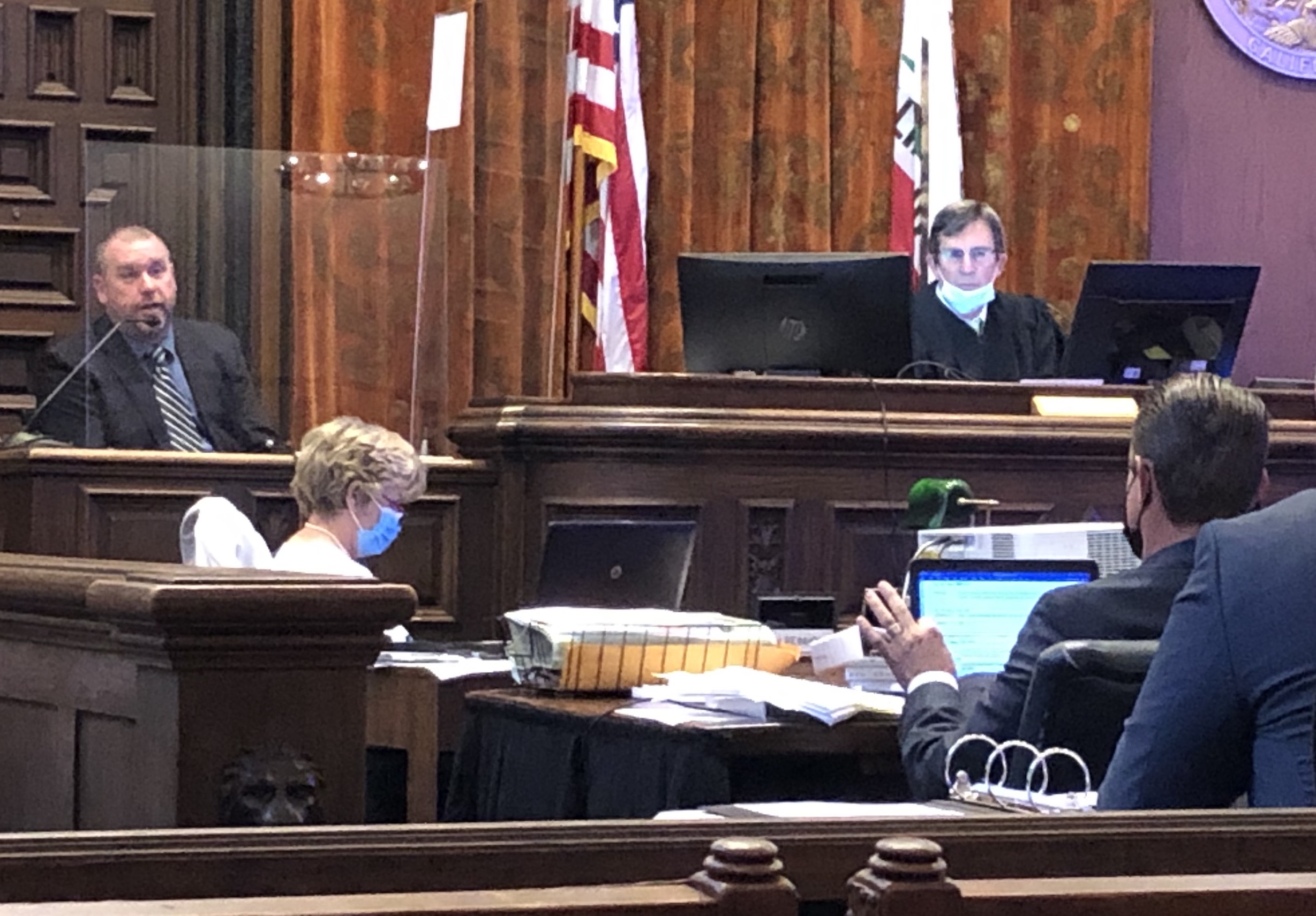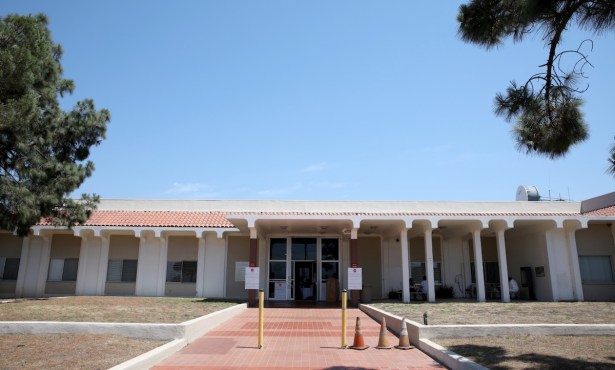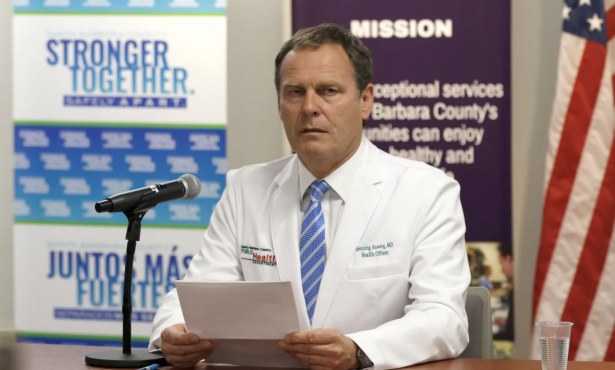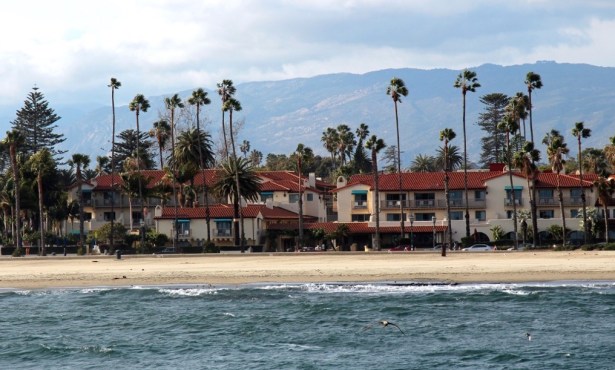Grim Friday Hearing in Haobsh Trial
Photos Displayed of Triple Murder Victims as Evidence Unfolds

Most of the verbal swordplay of the Pierre Haobsh murder trial Friday morning went to impeaching witnesses, but the evidence presented later in the day reminded everyone in Judge Brian Hill’s courtroom of the horrible crime the man at the defense table was accused of committing. From the witness stand, Santa Barbara County Sheriff’s Detective Travis Henderson verified that what looked like big plastic cocoons found in the Han family’s garage on March 23, 2016, held the murdered remains of the well-respected herbalist Dr. Henry Han; his wife, Jenny Yu; and their 5-year-old daughter, Emily Han.
Prosecutor Ben Ladinig directed Henderson through a description of the photos, with the help of Deputy DA Casey Nelson, while a handful of reporters and a couple members of the public watched. The slideshow started with an aerial of the seven acres of avocado orchard and chaparral around the Hans’ home on Greenhill Way in Noleta, narrowed to a side window in the garage, and then to the bodies wrapped in clear plastic sheeting and duct tape alongside the detritus of home life — a pink bicycle helmet, a car seat, boxes of stuff, random furniture, and clothing — beside two vehicles in the garage.
The scene switched to an Arco station in Bonsall, California, where Haobsh was arrested just after midnight on March 25, 2016, and photos of his red Lexus, cell phones, sales receipts, and a Glock 9mm barely visible beneath the driver’s seat. Next was surveillance video from Arizona Firearms, where Haobsh is seen purchasing a Glock 9mm, a Ruger .22, and three boxes of ammunition on March 19. Several more photos displayed the plastic sheeting, rolls of duct tape, drill, grinder, and welding brazer that officers had bought in duplicating Haobsh’s purchases per receipts found in his red Lexus. Other slides showed Haobsh visiting El Capitán State Park on March 22 and also evidence of his phone being used to search online for information on making a silencer, before Judge Hill noted it was nearly 4:30 p.m. and the presentation ended for the day.
Before the prosecutors tied their evidence against Haobsh together — defense attorney Christine Voss will likely cross-examine Henderson on Monday — in the morning, the court had viewed a couple hours of video in which Detective Jeff McDonald questioned Haobsh soon after he was arrested. Haobsh has never admitted to killing the Hans — except to a friend, T.J. Direda, whose testimony was collected by McDonald, and whom lead defense attorney Christine Voss attempted to demolish as an unreliable witness.
McDonald had questioned Haobsh for four hours, and earlier sections of the video were shown last Friday, depicting an increasingly unraveled Haobsh. If the video of McDonald’s later questioning is anything to go by, Haobsh decided to hold his tongue. During the course of the hour of video viewed this Friday morning in court, Haobsh answers “mm-hm” and “right,” alternating with “sure” as McDonald tries over and over in every conceivable line of questioning to awaken a sense of self-preservation in Haobsh that would align with him giving facts about the murder of the Han family. Haobsh never takes the bait.
The mostly one-sided and difficult to hear conversation was broad: would prosecutors make him an offer, would he be visited in prison by women, how many years did McDonald think he faced, and an exchange about Haobsh calling himself a “monster” to his friend T.J. Direda. There, McDonald agreed it was monstrous to kill a child but that Haobsh could be a good person if he’d talk about it, give people the comfort of knowing what had happened, and would feel better to unburden himself. Haobsh would only eventually say, after long silences, that theoretically, if he had done something like that, nobody would have felt anything and nobody would have heard anything.
In her cross-examination, Voss noted that Detective McDonald had been working for 14 hours straight, traveling to Oceanside after midnight, where Haobsh was first held; listening in for an hour as police asked him questions; returning through Thousand Oaks, where he questioned Direda; and then continuing to Santa Barbara, where Haobsh went to the hospital for chest pains; and McDonald then interrogated him for four hours.
Reviewing the seemingly incriminating texts Haobsh had sent Direda — “I’m screwed” and “If only I’d gotten there earlier” — and statements he’d made that accurately described the murder scene, Voss asked if McDonald had heard Haobsh tell Oceanside police that he’d killed five or six people before and been in a shootout in Arizona; she was incredulous when McDonald said he had not. He’d been listening in a separate conference room and not paying very much attention, he said. Amid a plethora of cross-talk and an objection from Ladinig, which was ultimately withdrawn, Voss explained her line of questioning was to plant the seed that Haobsh might have had other reasons to tell Direda he was a monster.
Voss also noted the “untrue” statements McDonald had told Haobsh during the interrogation. Haobsh’s father had not actually cried on hearing of the accusation, forensics had not yet processed the duct tape for fingerprints at that time, Don Goldberg’s dinner w/ Dr. Han on Sunday was made up — Haobsh said he had had dinner with Dr. Han on Sunday — the blood on Haobsh’s ear was his own, and Jenny Yu’s phone was not “covered in blood.” Voss questioned McDonald about the conversation about Haobsh’s possible release in an ankle monitor: In his 19 years of law enforcement, he thought a suspect in a triple homicide could be released? she asked. McDonald temporized, saying, “There’s no such thing as absolutes. Anything is possible.” Voss replied, “Like unicorns?”
Voss further impugned what Direda had told McDonald, pointing out discrepancies about the 18-wheeler he said Haobsh intended to rent to move the bodies, that he’d put bodies in his car, and that the Hans didn’t have the $20 million Haobsh told Direda they did.
In his turn, Ladinig defended his evidence, stating that Haobsh had Henry Han’s cellphone and told Direda it was in order to withdraw money from the bank, and that Direda was correct in the essentials details of how the victims were killed and how the bodies had been left. Ladinig also noted an MOU — or memorandum of understanding — had been found near a pool of blood that named both Han and Haobsh in a $25 million deal over a proprietary process, the details of which were not given.
The day’s hearing ended with the prosecution’s third attorney, veteran Hilary Dozer, contending with Voss over documents relied upon by her ballistics expert. That testimony is expected to occur on Monday, and Judge Hill, who is hearing the case rather than a jury, warned Voss that it might be paused if prosecutors needed more information from her expert.



